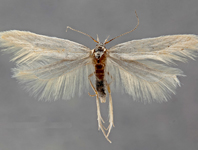Abstract
Few species of Baltic amber Psychodinae have been described to date. Some were incorrectly classified in Pericoma Walker based on an early, broad definition of the genus and holotypes were not specified. We examined approximately 50 specimens of Baltic amber Psychodinae in addition to reviewing the original series studied by Fernand Meunier. Lectotypes for Pericoma formosa Meunier and P. speciosa Meunier are designated and Paleotelmatoscopus gen. nov. is proposed to include P. formosa and P. madrizi sp. nov. Characters included in the diagnosis of this new genus and species have implications for future descriptions of Baltic amber Psychodinae. Parts of the head capsule, such as antennae, are often well-preserved and visible, and can be useful for separating species. However, these character complexes are prone to homoplasy and should not be used alone to define genera. Since it is impossible to view internal genitalic characters in fossil species, refinement of generic and species diagnoses based on external morphology is a critical factor in describing the amber fauna.
References
Botosaneanu, L. & Vaillant, F. (1970) Trois Diptères Psychodidae nouveaux de Cuba. Travaux du Laboratoired’Hydrobiologie et de Pisciculture de l’Universite de Grenoble, 61, 173–183.
Briggs, D.E.G. (2018) Sampling the insects of the amber forest. Proceedings of the National Academy of Sciences of the United States of America, 115 (26), 6525–6527.
https://doi.org/10.1073/pnas.1807017115
Cumming, J.M. & Wood, D.M. (2017) Adult morphology and terminology. In: Kirk-Spriggs, A. & Sinclair, B. (Eds.), Manual of Afrotropical Diptera. Vol. 1. Introductory Chapters and keys to Diptera families. South African National Biodiversity Institute, Pretoria, pp. 9–502.
Duckhouse, D.A. (1975) Non-phlebotomine Psychodidae (Diptera, Nematocera) of southern Africa. I. Subfamily Psychodinae: Pericoma Clytocerus and Mystropsychoda gen. n. Annals of the Natal Museum, 22 (2), 421–448.
Duckhouse, D.A. (1978) Non-phlebotomine Psychodidae (Diptera, Nematocera) of southern Africa. II. Subfamily Psychodinae: Neoarisemus and the brunettoid and telmatoscopoid genera. Annals of the Natal Museum, 23 (2), 305–359.
Duckhouse, D.A. (1987) A revision of Afrotropical Setomima, elucidation of their genealogical relationships and descriptions of other Afrotropical Psychodinae (Diptera: Psychodidae). Annals of the Natal Museum, 28, 231–282.
Eaton, A.E. (1893) A synopsis of British Psychodidae. Entomologist’s Monthly Magazine, 29, 5–8 + 31–34 + 120–130.
Eaton, A.E. (1904) New genera of European Psychodidae. Entomologist’s Monthly Magazine, 29, 32–33.
Enderlein, G. (1935) Zur Klassifikation der Psychodinen. Sitzungsberichte der Gesellschaft Naturforschender Freunde zu Berlin, 1935, 246–249.
Fowler, M.J.F. (2018) Eocene world: fossil insects from Baltic amber. Bulletin of the Amateur Entomologists’ Society, 77, 178–188.
Haenni, J.-P. (2003) Fossil Diptera in Baltic amber: the collection of the Muséum d’histoire naturelle Neuchâtel. Acta Zoologica Cracoviensia, 46 (Supplement—Fossil Insects), 407–410.
Hennig, W. (1972) Insektenfossilien aus der unteren Kreide IV. Psychodidae (Phlebotominae), mit einer kritischen Ubersicht uber das phylogenetische System der Familie und die bisher beschriebenen Fossilien (Diptera). Stuttgarter Beitrage zur Naturkunde, 241, 1–69.
Hoffeins, C. & Hoffeins, H.W. (2003) Untersuchungen über die Häufigkeit von Inklusen in Baltischem und Bitterfelder Bernstein (Tertiär, Eozän) aus unselektierten Aufsammlungen unter besonderer Berücksichtigung der Ordnung Diptera [On the frequency of inclusions in Baltic and Bitterfeld amber (Tertiary, Eocene) from unselected material, with special reference to the order Diptera]. Studia Dipterologica, 10 (2) 381–392.
Ježek, J. (1989) Contribution to the taxonomy of the genus Telmatoscopus Eat. (Diptera, Psychodidae). Acta Musei Nationalis Pragae, 46, 75–104.
Krzemiński, W. & Krzemińska, E. (2003) Triassic Diptera: descriptions, revisions and phylogenetic relations. Acta Zoologica Cracoviensia, 46 (Supplement—Fossil Insects), 153–184.
Kvifte, G.M. (2014) Nomenclature and taxonomy of Telmatoscopus Eaton and Seoda Enderlein; with a discussion of parameral evolution in Paramormiini and Pericomaini (Diptera: Psychodidae, Psychodinae). Zootaxa, 3878 (4), 390–400.
https://doi.org/10.11646/zootaxa.3878.4.5
Kvifte, G.M. & Wagner, R. (2017) Psychodidae (Sand Flies, Moth Flies or Owl Flies). In: Kirk-Spriggs, A. & Sinclair, B. (Eds.), Manual of Afrotropical Diptera. Vol. 2. Nematocerous Diptera and Lower Brachycera. South African National Biodiversity Institute, Pretoria, pp. 607–632.
Linnaeus, C. (1758) Systema Naturae per Regna Tria Naturae, Secundum Classes, Ordines, Genera, Species, cum Caracteribus, Differentiis, Synonymis, Locis. Vol. 1. regnum animale.Editio decima, reformata. Laurentii Salvii, Stockholm, 824 pp.
https://doi.org/10.5962/bhl.title.542
Loew, H. (1845) Dipterologische Beiträge. I. [Progr.]. K. Friedrich-Wilhelms-Gymnasiums, Posen, 50 pp. [1845]
https://doi.org/10.5962/bhl.title.48649
Meunier, F. (1905) Monographie des Psychodidae de l’Ambere de la Baltique. Annales Musei Nationalis Hungarici, 3, 235–255, tabs. VI + VII. [table legends interchanged]
Newman, E. (1834) Attempted division of British insects into natural orders. Entomological Magazine, 2, 379–431.
Oboňa, J. & Ježek, J. (2012) First records of dendrolimnetic moth flies (Diptera: Psychodidae) from Slovakia. Klapalekiana, 48, 279–287.
Omelková, M. & Ježek, J. (2017) Two new species of Jungiella (Diptera: Psychodidae: Psychodinae) from the Palaearctic Region. Zootaxa, 4250 (6), 560–576.
https://doi.org/10.11646/zootaxa.4250.6.4
O’Leary, M.A. & Kaufman, S.G. (2011) MorphoBank: phylophenomics in the ‘cloud’. Cladistics, 27, 1–9.
https://doi.org/10.1111/j.1096-0031.2011.00355.x
O’Leary, M.A. & Kaufman, S.G. (2012) MorphoBank 3.0: Web application for morphological phylogenetics and taxonomy. Available from: http://www.morphobank.org (accessed 21 January 2021)
Seyfullah, L.J., Beimforde, C., Dal Corso, J., Perrichot, V., Rikkinen, J. & Schmidt, A.R. (2018) Production and preservation of resins—past and present. Biological Reviews, 93, 1684–1714.
https://doi.org/10.1111/brv.12414
Sontag, E. (2003) Animal inclusions in a sample of unselected Baltic amber. Acta Zoologica Cracoviensia, 46 (Supplement—Fossil Insects), 431–440.
Vaillant, F. (1989) Les Psychodidae dendrolimnophiles et dendrolimnobiontes paléarctiques et néarctiques (Insecta, Diptera, Nematocera, Psychodidae). Spixiana, 12, 193–208.
Walker, F. (1856) Insecta Britannica. Diptera. Vol. III. Reeve & Benham, London, 352 pp.


